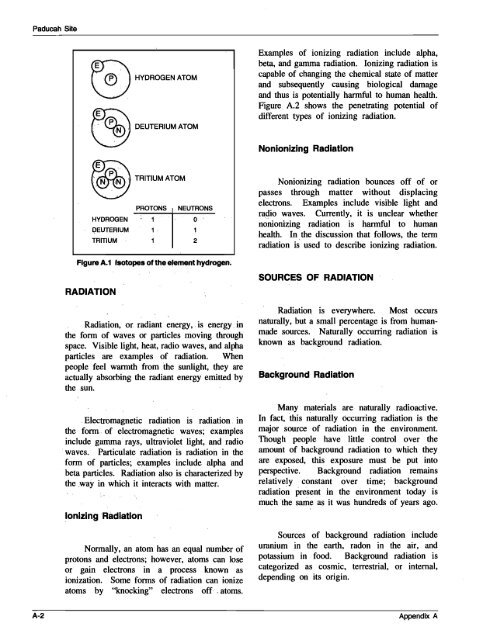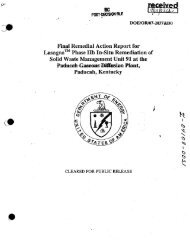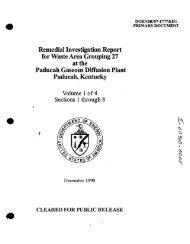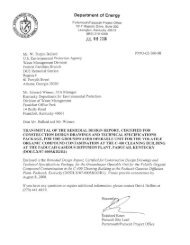1 - paducah environmental information center
1 - paducah environmental information center
1 - paducah environmental information center
You also want an ePaper? Increase the reach of your titles
YUMPU automatically turns print PDFs into web optimized ePapers that Google loves.
Paducah Site<br />
~ HYDROGEN ATOM<br />
~ DEUTERIUM ATOM<br />
Examples of ionizing radiation include alpha,<br />
beta, and gamma radiation. Ionizing radiation is<br />
capable of changing the chemical state of matter<br />
and subsequently causing biological damage<br />
and thus is potentially harmful to human health.<br />
Figure A.2 shows the penetrating potential of<br />
different types of ionizing radiation.<br />
Nonionizing Radiation<br />
~E- '.<br />
. P-<br />
".~, TRITIUM ATOM<br />
P.AOTONS .1 NEUTRONS<br />
HYDROGEN :. 1 . 0 .'<br />
DEUTERIUM 1 .' 1<br />
TRITIUM· 1 2<br />
Figure A.1 Isotopes of the element hydrogen.<br />
RADIATION<br />
Radiation, or radiant energy, is energy. in<br />
the form of waves or particles moving through<br />
space. Visible light, heat, radio waves, and alpha<br />
particles are examples of radiation. When<br />
people feel warmth from the sunlight, they are<br />
actually absorbing the radiant energy emitted by<br />
the sun.<br />
. Electromagnetic radiation is radiation. in<br />
the form of electromagnetic waves; examples<br />
include gamma rays, ultraviolet light, and radio<br />
waves. Particulate radiation is radiation in the<br />
form of particles; examples include alpha and<br />
beta particles. Radiation also is characterized by<br />
the way in which it interacts with matter.<br />
Ionizing -Radiation<br />
Normally, an atom has an equal number of<br />
protons and electrons; however, atoms can lose<br />
or gain electrons in a process known as<br />
ionization. Some forms of radiation can ionize<br />
atoms by "knocking" electrons off, atoms.<br />
Nonionizing radiation bounces off of or<br />
passes through matter without displacing<br />
electrons. Examples include visible light and<br />
ra4io waves. Currently, it is unclear whether<br />
nonionizing radiation is harmful to human<br />
health. In . the discussion that follows, the term<br />
radiation is used to describe ionizing radiation.<br />
SOURCES OF RADIATION<br />
Radiation is everywhere. Most occurs<br />
naturally, but a small percentage is from humanmade<br />
sources. Naturally occurring radiation is<br />
known as background radiation.<br />
Background Radiation<br />
Many materials are naturally radioactive.<br />
In fact, this naturally occurring radiation is the<br />
major source of radiation in the environment.<br />
Though people have little control over the<br />
amount of background radiation to which they<br />
are exposed, this exposure must be put into<br />
perspective. Background radiation remains<br />
relatively constant over time; background<br />
radiation present in the environment today is<br />
much the saffi~ as it was hundreds of years ago.<br />
Sources of background radiation include<br />
uranium in the earth, radon in the air, and<br />
potassium in food. Background radiation is<br />
categorized as cosmic, terrestrial, or internal,<br />
depending on its origin.<br />
A-2<br />
Appendix A

















